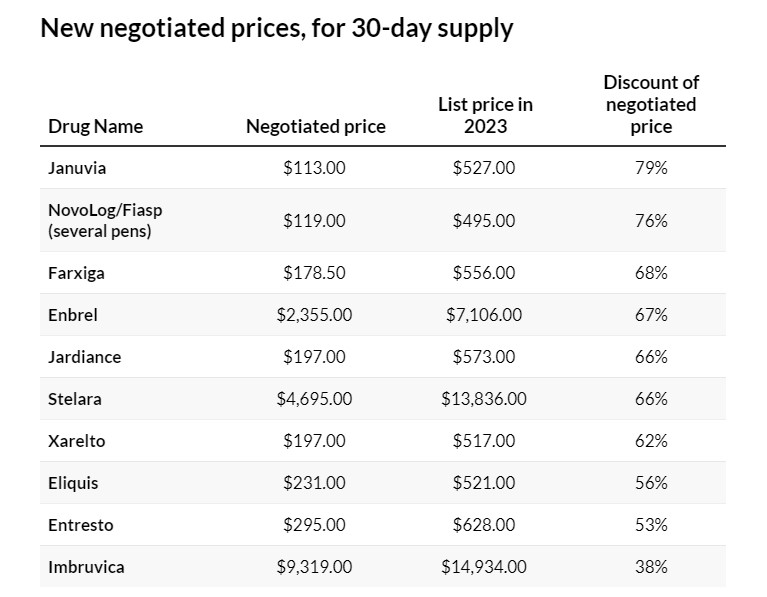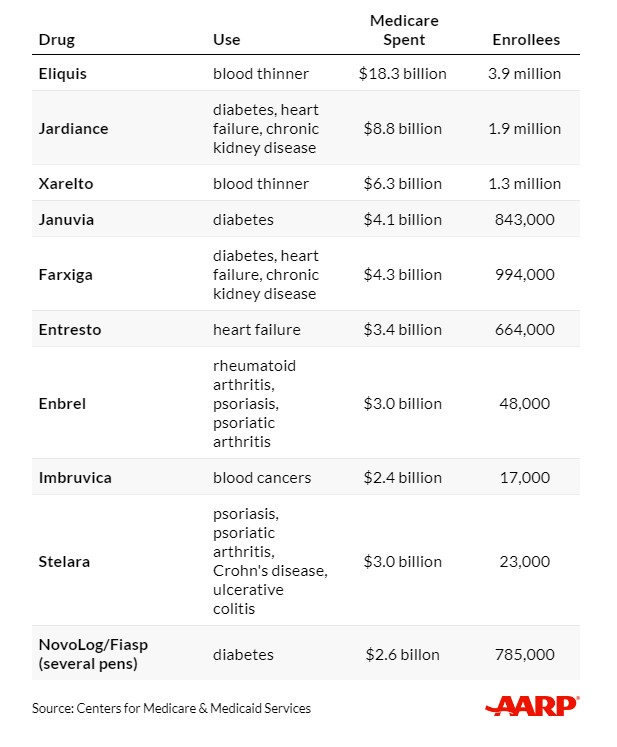AARP Eye Center

Under the new prescription drug law and for the first time in history, Medicare has negotiated lower prices for 10 medications that are among the costliest and most used in its prescription drug program (Part D). Every year going forward, the federal program will select additional drugs to negotiate.
The new prices negotiated by the federal government and drug manufacturers take effect in 2026 and apply to prescription pills and injections taken by older adults for diabetes, blood clots, heart failure, arthritis, kidney disease, cancer and more. About 9 million Medicare enrollees in 2023 used one or more of the 10 drugs selected.
Medicare Part D enrollees, who often pay a percentage of a drug’s cost, are expected to save a collective $1.5 billion in out-of-pocket expenses in 2026 because of the price negotiations, government officials announced. If the negotiated prices had been in effect last year, Medicare would have saved an estimated $6 billion.
“Americans pay way too much for their prescription drugs. That’s what makes today’s announcement so historic,” U.S. Department of Health and Human Services (HHS) Secretary Xavier Becerra said on a call with reporters. “For the first time ever, Medicare negotiated directly with drug companies, and the American people are better off for it.”
“These negotiated prices, they’re not just about cost,” added Centers for Medicare & Medicaid Services (CMS) Administrator Chiquita Brooks-LaSure. “They are about helping to make sure that your aunt, your father, your grandfather or you can live longer and healthier.”
Some of the negotiated prices are steep discounts compared to the drugs’ list prices. For example, a 30-day supply of Januvia, a diabetes drug, is discounted 79 percent from the 2023 list price. And the negotiated price for the NovoLog pen, also used for diabetes, is 76 percent lower than the list price.
Comparisons to list prices, however, don’t give a clear picture on how much less Medicare’s prescription drug plans will pay for the 10 medications, since plans often negotiate lower prices. These prices are kept confidential.
“It’s difficult to say exactly how much Medicare prescription drug plans were paying for the 10 medications, but the savings expected by CMS indicate that it was able to negotiate prices that were even lower,” says Leigh Purvis, AARP’s prescription drug policy principal.

Source: Centers for Medicare & Medicaid Services
Lower prices are result of AARP-backed law
The first 10 prescription medications selected for negotiations were identified last August as part of an AARP-backed prescription drug law that expands health care benefits and lowers out-of-pocket expenses for millions of older Americans with Medicare.
Federal officials picked the 10 drugs from a list of 50 medications that Medicare Part D spends the most on and are among the most used. Any selected small molecule drugs — medications you typically get at the pharmacy and take orally — must have been approved by the U.S. Food and Drug Administration (FDA) for at least seven years with no generic alternative. Biologics, which are drugs made from living organisms rather than chemicals, must have been FDA approved for at least 11 years with no similar alternatives.
The 10 selected drugs accounted for more than $56 billion in Part D spending in 2023, according to HHS, and people with Medicare prescription drug coverage taking these 10 medications paid a total of $3.4 billion in out-of-pocket costs in 2022.
“Today’s announcement marks a significant step forward in our long-standing efforts to lower prescription drug prices,” says Nancy LeaMond, AARP executive vice president and chief advocacy and engagement officer. “AARP members from across the political spectrum overwhelmingly called lowering prescription drug costs a top concern — and this first round of Medicare-negotiated prices will bring financial relief to millions of older Americans.”
The 10 drugs treat common conditions among older adults
- One person dies of a blood clot every six minutes in the U.S., according to the Centers for Disease Control and Prevention (CDC). About 1 in 10 Medicare enrollees have heart conditions that put them at risk of blood clots
- About 28% of Medicare enrollees have diabetes, which is one of the top 10 leading causes of death in the U.S.
- About 42% of Medicare enrollees ages 65 and older have at least one heart-related condition. Heart disease is the leading killer in the U.S.
- About 1 in 4 adults with Medicare have chronic kidney disease.
- Thirty-five percent of Medicare enrollees have arthritis (osteoarthritis or rheumatoid arthritis).
- About 15% of adults with Medicare have a cancer diagnosis.
Source: U.S. Department of Health and Human Services
Many older Americans struggle to afford medication
A 2023 survey from AARP shows that 60 percent of older adults are very or somewhat concerned about being able to afford the prescription medication that they or someone in their family needs, and HHS reports that more than 5 million Medicare enrollees face challenges when it comes to affording their prescription medications.
This can have dangerous consequences. A 2023 poll from the health policy nonprofit KFF found that about 30 percent of adults don’t take their medications as prescribed due to high costs.
Several polls, including research conducted by AARP, have found overwhelming public support for price negotiations between the federal government and drug maker
Barbara Fabyan’s 73-year-old husband takes three medications whose prices were negotiated by Medicare. Before he started taking these and other drugs, the couple never hit Medicare Part D’s coverage gap — a temporary limit on what the prescription drug plan will cover for a person’s medications.
But in 2023, they reached the gap in March and noticed a significant jump in how much they paid out of pocket when they filled their prescriptions. “Talk about a sticker shock at the pharmacy,” says Fabyan, a retired educator near Fort Wayne, Indiana.
This year, they hit that gap even quicker. “It certainly affects our savings, because that’s what we draw from to pay those extra medicine costs,” she says. “Some of the things like going out to eat, things like that, we just don’t do as much.”
The coverage gap will be eliminated in 2025, under the AARP-backed prescription drug law, and people with a Medicare prescription drug plan will start to benefit from a new limit on out-of-pocket expenses for their prescription medications. (This limit will be $2,000 in 2025.)
“As the voice for the 100 million Americans ages 50-plus, we will continue working to ensure this law is fully implemented and benefits older Americans for decades to come,” AARP’s LeaMond said.

More drug negotiations on the horizon
These first 10 medications are just the beginning for Medicare prescription drug price negotiations. Under the law, CMS will select and negotiate the prices of 15 more drugs for 2027, another 15 for 2028 and 20 additional drugs each year after that. The nonpartisan Congressional Budget Office has estimated that these negotiations will not only benefit consumers but will save the Medicare program $98.5 billion over 10 years.
Other provisions in the AARP-backed prescription drug law are also helping to make medications more affordable to older adults with Medicare. For example, a $35 monthly copay cap for insulin took effect in 2023 for people with Medicare prescription drug plans, and coinsurance amounts have been lowered for certain medications whose prices have been rising faster than the rate of inflation.
Many lifesaving vaccines have been made free for people in Medicare prescription drug plans, and importantly, a new annual cap on out-of-pocket expenses for prescription medications will take effect Jan. 1, 2025 (the cap will be $2,000 in 2025), offering much-needed savings and peace of mind for older adults with high drug expenses.
“Older adults have been struggling with high prescription drug prices for too long. The announcement of the first Medicare-negotiated drug prices is just the latest evidence of how the 2022 prescription drug law is creating much-needed savings for Medicare beneficiaries, as well as the Medicare program and the taxpayers who fund it,” AARP’s Purvis says.
Key dates for price negotiations
- By Feb. 1, 2025: CMS will announce up to 15 drugs covered under Part D subject to negotiations for prices that will become effective in 2027.
- March 1, 2025: deadline for CMS to publish the explanation of the maximum fair prices that have been negotiated for the first 10 drugs selected for negotiation for 2026.
- By Nov. 30, 2025: CMS will announce the maximum fair prices for the 15 drugs selected in February 2025.
- Jan. 1, 2026: Maximum fair prices negotiated for first 10 selected drugs become effective.
- 2027: Negotiated prices for 15 additional drugs take effect.
- 2028: Negotiated prices for another 15 drugs take effect.
- 2029 and beyond: Negotiated prices for 20 additional drugs per year take effect.
Reporting from the late Dena Bunis was used in this story.
Rachel Nania is an award-winning health editor and writer at AARP.org, who covers a range of topics including diseases and treatments.























































